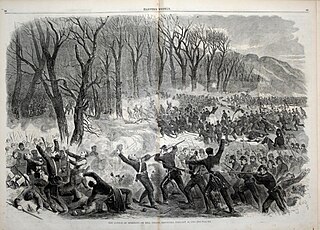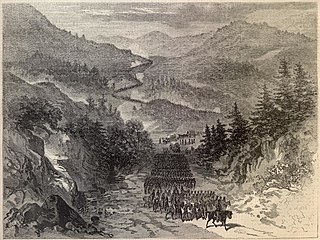
The Battle of Chickamauga, fought on September 18–20, 1863, between the United States Army and Confederate forces in the American Civil War, marked the end of a U.S. Army offensive, the Chickamauga Campaign, in southeastern Tennessee and northwestern Georgia. It was the first major battle of the war fought in Georgia and the most significant US defeat in the Western Theater, and it involved the second-highest number of casualties after the Battle of Gettysburg.

The Battle of Lookout Mountain also known as the Battle Above the Clouds was fought November 24, 1863, as part of the Chattanooga Campaign of the American Civil War. Union forces under Maj. Gen. Joseph Hooker assaulted Lookout Mountain, Chattanooga, Tennessee, and defeated Confederate forces commanded by Maj. Gen. Carter L. Stevenson. Lookout Mountain was one engagement in the Chattanooga battles between Maj. Gen. Ulysses S. Grant's Military Division of the Mississippi and the Confederate Army of Tennessee, commanded by Gen. Braxton Bragg. It drove in the Confederate left flank and allowed Hooker's men to assist in the Battle of Missionary Ridge the following day, which routed Bragg's army, lifting the siege of Union forces in Chattanooga, and opening the gateway into the Deep South.

The Battle of Stones River, also known as the Second Battle of Murfreesboro, was fought from December 31, 1862, to January 2, 1863, in Middle Tennessee, as the culmination of the Stones River Campaign in the Western Theater of the American Civil War. Of the major battles of the war, Stones River had the highest percentage of casualties on both sides. The battle ended in Union victory after the Confederate army's withdrawal on January 3, largely due to a series of tactical miscalculations by Confederate Gen. Braxton Bragg, but the victory was costly for the Union army. Nevertheless, it was an important victory for the Union because it provided a much-needed boost in morale after the Union's recent defeat at Fredericksburg and also reinforced President Abraham Lincoln's foundation for issuing the Emancipation Proclamation, which ultimately discouraged European powers from intervening on the Confederacy's behalf.

The Battle of Perryville, also known as the Battle of Chaplin Hills, was fought on October 8, 1862, in the Chaplin Hills west of Perryville, Kentucky, as the culmination of the Confederate Heartland Offensive during the American Civil War. Confederate Gen. Braxton Bragg's Army of Mississippi initially won a tactical victory against primarily a single corps of Maj. Gen. Don Carlos Buell's Union Army of the Ohio. The battle is considered a strategic Union victory, sometimes called the Battle for Kentucky, since Bragg withdrew to Tennessee soon thereafter. The Union retained control of the critical border state of Kentucky for the remainder of the war.

The Battle of Missionary Ridge, also known as the Battle of Chattanooga, was fought on November 25, 1863, as part of the Chattanooga campaign of the American Civil War. Following the Union victory in the Battle of Lookout Mountain on November 24, Union forces in the Military Division of the Mississippi under Maj. Gen. Ulysses S. Grant assaulted Missionary Ridge and defeated the Confederate Army of Tennessee, commanded by Gen. Braxton Bragg, forcing it to retreat to Georgia.
The First Battle of Chattanooga was a minor artillery battle in the American Civil War, fought on June 7–8, 1862.

The Tullahoma campaign was a military operation conducted from June 24 to July 3, 1863, by the Union Army of the Cumberland under Maj. Gen. William Rosecrans, and is regarded as one of the most brilliant maneuvers of the American Civil War. Its effect was to drive the Confederates out of Middle Tennessee and to threaten the strategic city of Chattanooga.
The First Battle of Murfreesboro was fought on July 13, 1862, in Rutherford County, Tennessee, as part of the American Civil War. Troops under Confederate cavalry commander Brig. Gen. Nathan Bedford Forrest surprised and quickly overran a Federal hospital, the camps of several small Union units, and the jail and courthouse in Murfreesboro, Tennessee. All of the Union units surrendered to Forrest, and the Confederates destroyed much of the Union's supplies and destroyed railroad track in the area. The primary consequence of the raid was the diversion of Union forces from a drive on Chattanooga.

The Battle of Mill Springs, also known as the Battle of Fishing Creek in the Confederacy, and the Battle of Logan's Cross Roads or Battle of Somerset in the Union, was fought in Wayne and Pulaski counties, near the current unincorporated community of Nancy, Kentucky, on January 19, 1862, as part of the American Civil War. The Union victory concluded an early Confederate offensive campaign in south central Kentucky.
The Battle of Davis's Cross Roads, was fought September 10–11, 1863, in northwestern Georgia, as part of the Chickamauga Campaign of the American Civil War. It was more of a series of maneuvers and skirmishes than an actual battle and casualties were negligible.

Campbell Slemp was a farmer and Confederate officer in southwest Virginia who became a Readjuster Democrat after Congressional Reconstruction and served in the Virginia House of Delegates. He eventually joined the Republican Party and won election to the United States House of Representatives from Virginia's 9th congressional district and controlled federal patronage in the Commonwealth from 1903 to 1907. Slemp died unexpectedly at home while in office, after which his son C. Bascom Slemp succeeded to the seat for more than a decade, until being ousted by the rising Byrd Organization.

The Battle of Chickasaw Bayou, also called the Battle of Walnut Hills, fought December 26–29, 1862, was the opening engagement of the Vicksburg Campaign during the American Civil War. Confederate forces under Lt. Gen. John C. Pemberton repulsed an advance by Union Maj. Gen. William T. Sherman that was intended to lead to the capture of Vicksburg, Mississippi.

The Big Sandy Expedition was an early campaign of the American Civil War in Kentucky that began in mid-September 1861 when Union Brig. Gen. William "Bull" Nelson received orders to organize a new brigade at Maysville, Kentucky and conduct an expedition into the Big Sandy Valley region of Eastern Kentucky and stop the build-up of Confederate forces under Col. John S. Williams. This was done in three phases. From September 21 to October 20, 1861, Nelson assembled a brigade of 5,500 Union volunteers from Ohio and Kentucky. On October 23, the southern prong secured Hazel Green and the northern prong West Liberty. The two prongs were consolidated at Salyersville and they began the final phase on October 31. This led to the Battle of Ivy Mountain on November 8 and the withdrawal of Confederate forces from Pikeville (Piketon) on November 9, 1861.

The western theater of the American Civil War encompassed major military operations in the states of Alabama, Georgia, Florida, Mississippi, North Carolina, Kentucky, South Carolina and Tennessee, as well as Louisiana east of the Mississippi River. Operations on the coasts of these states, except for Mobile Bay, are considered part of the Lower Seaboard Theater. Most other operations east of the Appalachian Mountains are part of the eastern theater. Operations west of the Mississippi River took place in the trans-Mississippi theater.

James Edwards Rains was a lawyer and colonel in the Confederate States Army during the American Civil War. He was appointed and nominated as a brigadier general on November 4, 1862, but his appointment was unconfirmed at the date of his death. He was killed while leading his brigade at the Battle of Stones River (Murfreesboro) on December 31, 1862, before the Confederate States Senate acted on his nomination.

The Knoxville campaign was a series of American Civil War battles and maneuvers in East Tennessee, United States, during the fall of 1863, designed to secure control of the city of Knoxville and with it the railroad that linked the Confederacy east and west, and position the First Corps under Lt. Gen. James Longstreet for return to the Army of Northern Virginia. Union Army forces under Maj. Gen. Ambrose Burnside occupied Knoxville, Tennessee, and Confederate States Army forces under Longstreet were detached from Gen. Braxton Bragg's Army of Tennessee at Chattanooga to prevent Burnside's reinforcement of the besieged Federal forces there. Ultimately, Longstreet's Siege of Knoxville ended when Union Maj. Gen. William Tecumseh Sherman led elements of the Army of the Tennessee and other troops to Burnside's relief after Union troops had broken the Confederate siege of Chattanooga. Although Longstreet was one of Gen. Robert E. Lee's best corps commanders in the East in the Army of Northern Virginia, he was unsuccessful in his attempt to penetrate the Knoxville defenses and take the city.
The 19th Tennessee Infantry Regiment, or Nineteenth Tennessee Volunteer Infantry Regiment, was an infantry regiment in the Confederate States Army during the American Civil War. The 19th Tennessee fought in every major battle and campaign of the Army of Tennessee except the Battle of Perryville. First Lieutenant Robert D. Powell of Company K, killed at the Battle of Barbourville, Kentucky, is believed to be the first soldier killed during the Civil War in that state.

The September 7–9, 1863 fall of the Cumberland Gap was a victory for Union forces under the command of Ambrose Burnside during his campaign for Knoxville. The bloodless engagement cost the Confederates 2,300 men captured and control of the Cumberland Gap.

The Chattanooga campaign was a series of maneuvers and battles in October and November 1863, during the American Civil War. Following the defeat of Maj. Gen. William S. Rosecrans's Union Army of the Cumberland at the Battle of Chickamauga in September, the Confederate Army of Tennessee under Gen. Braxton Bragg besieged Rosecrans and his men by occupying key high terrain around Chattanooga, Tennessee. Maj. Gen. Ulysses S. Grant was given command of Union forces in the West which was now consolidated under the Division of the Mississippi. Significant reinforcements also began to arrive with him in Chattanooga from Mississippi and the Eastern Theater. On October 18, Grant removed Rosecrans from command of the Army of the Cumberland and replaced him with Major General George Henry Thomas.

The Battle of Augusta was an engagement during the American Civil War that took place on September 27, 1862, in Augusta, Kentucky, between the Bracken County Home Guard (Union) and the Confederate Second Kentucky Cavalry Regiment under command of Colonel Basil W. Duke, a brother-in-law of John H. Morgan. The skirmish resulted in a victory for the Confederacy but the number of Confederate casualties and lack of ammunition for his artillery caused Colonel Duke to abandon plans to cross over the Ohio River into Ohio. A result of the fighting was that twenty buildings were set on fire and destroyed.
















